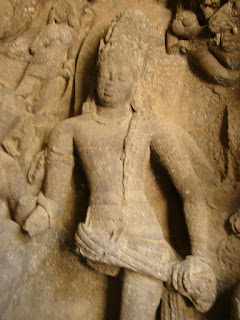Worship of Shiva as Nataraja during the Chola Era
Amongst one of the longest-ruling and influential dynasties of medieval southern India was the Chola dynasty whose Tamil-speaking emperors were ardent worshippers of Lord Shiva. During their reign from 850 CE to 1279 CE, the Cholas contributed significantly to the local arts culture of their time. Below is a stylized mural painting of one of the famous Chola Kings Rajaraja I (right) with his preceptor, who extensively contributed to Shaivite art culture.
 |
| Venu62, Rajaraja Mural (26 Feb 2006). Public Domain. |
While the Cholas primarily worshiped Shiva as the Shiva Linga, they were well-known in elevating the cult worship of Shiva as Nataraja- which means ‘Lord of the Dance’. The Chola dynasty was well known for constructing the globally popular bronze images of Shiva-Nataraja.
In fact, the Cholas took pride in this profound and influential representation of Shiva, that they not only adopted the Nataraja as a symbol of their dynasty but also as their Kuladevata or family deity.
The detailed explanation of the Nataraja is as follows: He is depicted having three eyes and four arms, dancing within a ‘flame-fringed’ ring upon a dwarfish-looking being, projecting a dance posture with one leg upraised and the other placed over the dwarfish being. The dwarfish being is debated to Apasmara or Muyalaka that denotes ignorance and the Nataraja’s planted foot on the dwarf signify triumph or control over illusion and the lifted foot of His grants salvation.
 |
| Rosemania, India Statue of Nataraja (30 Dec 2005). Creative Commons |
In fact, the Cholas took pride in this profound and influential representation of Shiva, that they not only adopted the Nataraja as a symbol of their dynasty but also as their Kuladevata or family deity.
The detailed explanation of the Nataraja is as follows: He is depicted having three eyes and four arms, dancing within a ‘flame-fringed’ ring upon a dwarfish-looking being, projecting a dance posture with one leg upraised and the other placed over the dwarfish being. The dwarfish being is debated to Apasmara or Muyalaka that denotes ignorance and the Nataraja’s planted foot on the dwarf signify triumph or control over illusion and the lifted foot of His grants salvation.
His lower right arm’s mudra or posture is referred to as abhaya hasta which signifies Shiva’s sign of assurance to his devotees in times of fear; while his lower left arm’s mudra that stretches across His body and points to His raised foot is called the danda hasta or elephant’s trunk pose that signifies the refuge He provides for His troubled devotees.
The Nataraja’s upper right and left-hand holds a double drum and a pot of agni (flame) respectively. The double drum signifies creation, as sound is presumed to be the foremost manifestation of creative energy while the flames represent the element of destruction from all sorts of evil.
Ultimately, the Nataraja conveys the power of Shiva to grant salvation to humans via his dance, that is known as Ananda tandava or the Dance of Bliss. This cosmic dance depicts the paradoxical nature of Shiva that is to create as well as destroy.
Being great patronizers of the arts themselves, the intricate and elegant predominantly bronze statue of Nataraja, coupled with its spiritual significance could have motivated the Cholas to heighten the worship and popularity of Shiva as Nataraja. Also, the power and sanctity of the Nataraja could have made the Chola emperors spread his worship as it might be a representation of their association with the divinity, which the Cholas could have utilized to glorify their reign. The temple where the Nataraja is believed to have first appeared is Thillai Nataraja temple that is located in the province of Chidambaram in Tamil Nadu, Southern India.
 |
| Karthik Easvur, Chidambaram temple tank 1 ( 24 Aug 2014). Creative Commons. |
The controversial exploitation of associating one’s kingship with divinity is something not unique to the Cholas. Emperors all over the globe have tapped on this factor to elevate their position of King to a higher pedestal. For example, as mentioned in lectures Mesopotamia’s Gilgamesh had also recounted his birth as a divine process that involved the Goddesses Aruru and Ishtar, probably as a mean to prove this worth as King by affiliating himself to the divine.
The Chola emperors, who mostly identify themselves as adherents of Shaivism, not only contributed to the Shaivite scene in their kingdom but also to places beyond India as well, especially Southeast Asia. There have been inscriptions of Chola monarchs such as Rajaraja I and Rajendra I who have conquered territories beyond the South Asian peninsula such as Sri Lanka and Kedah (a state in modern day Malaysia). In fact, images of the Nataraja have been identified in a Shiva temple of the 9th CE Prambanan Complex in Central Java. Indonesia, however, it is still debatable as to whether the Cholas are the cause of these images.
 |
| CEphoto and Uwe Aranas, Yogyakarta Indonesia Prambanan temple complex 02 (5 Feb 2015). Public Domain |

Comments
Post a Comment